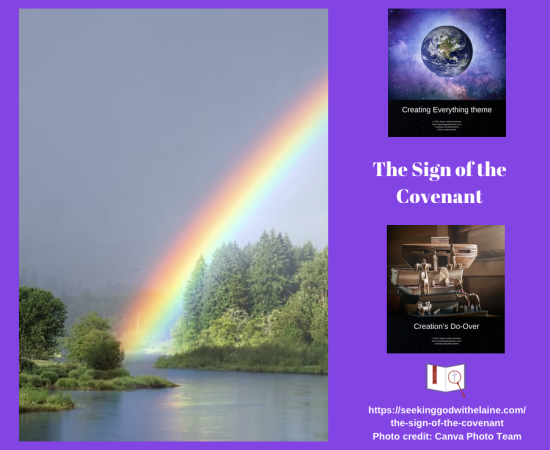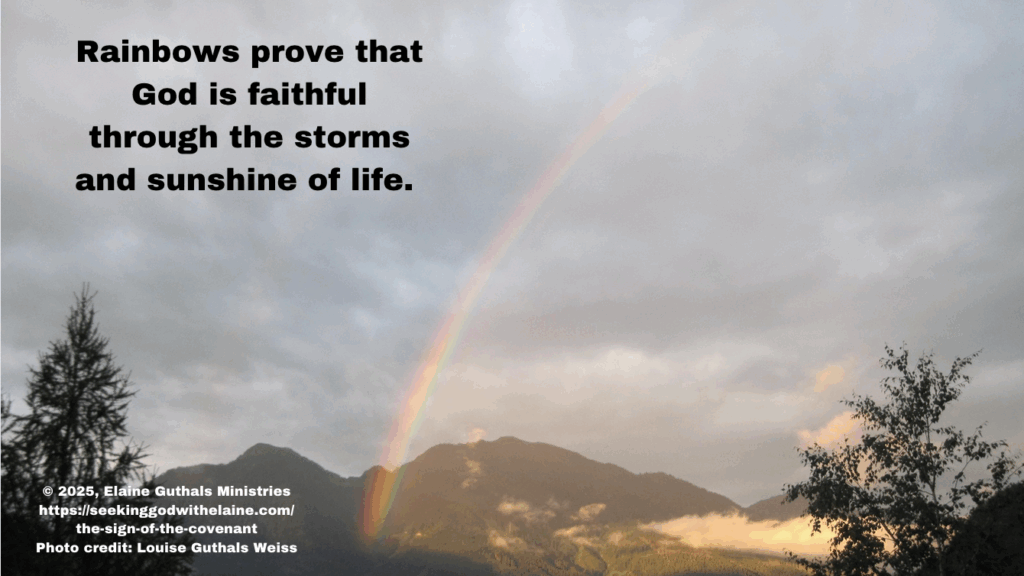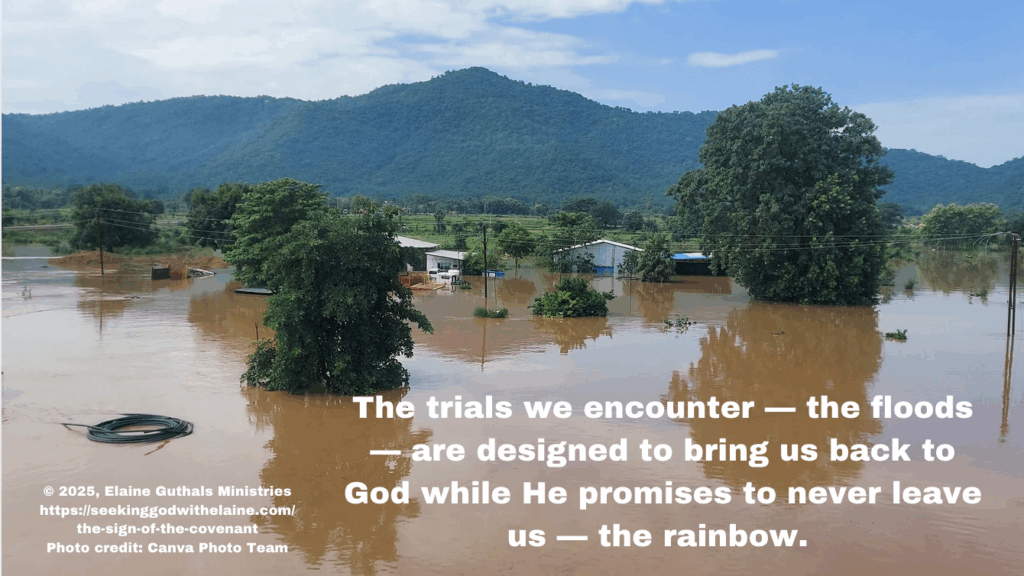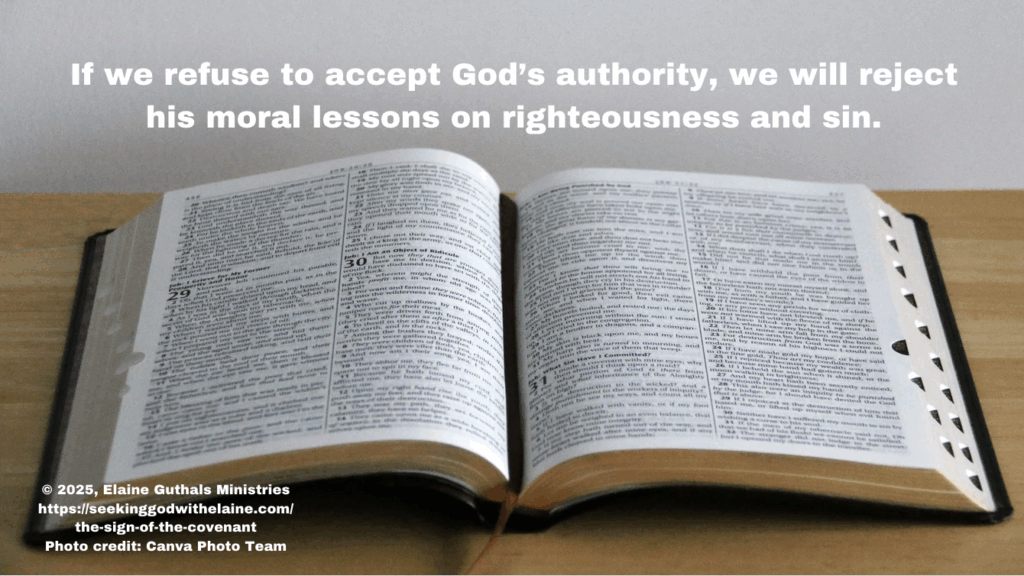The last part of the covenant between God and Noah was the sign. This devotional reading looks at the rainbow and its significance.
Nuggets
- The visual sign tells all that God’s care is everlasting.
- For the first time ever, the rainbow graced the sky.
- God says He will see the rainbow from Heaven.

Almost everyone – even non-believers – can tell you that the rainbow is a sign that God will not destroy the earth again by flooding it.
But what did God mean by it? How would that have been comforting to Noah?
Let's Put It into Context
To read devotions in the Creating Everything theme, click the button below.
Devotions in the Creation’s Do-Over series
The Sign of the Everlasting Covenant
“Then God said, ‘I am giving you a sign of my covenant with you and with all living creatures, for all generations to come” (Gen. 9: 12 NLT)
The visual sign of the covenant tells us that God’s care is everlasting.
In the last devotion, we talked about how Noah and his descendants probably had their stomachs flip every time a huge rain occurred. Was it starting again?
God not only chose to tell them about His promise not to flood the earth again, but He also gave a visual sign. No, God didn’t need the sign. We did.
The sign for this covenant has God continuing to use nature to teach us His spiritual truths through His power and wisdom. It is fitting that the rainbow is created by the sunlight returning after the rain. In other words, the rainbow is the product of the sunshine and rain.
Both the punishment for our disobedience and God’s grace and mercy are needed.
Ooo, baby. It is sometimes hard for us to wait for the sunshine when the thunder is booming, and the lightening is flashing.
Rainbows are an outward pledge and token that God will remember and hold dear the completion of the covenant. They prove that God is faithful through the storms and sunshine of life.

Look what Fairbairn said. He wrote,
“But in a matter like the present, when the specific object contemplated was to allay men’s fears of permanence of her existing order and constitution, one cannot perceive how a natural phenomenon, common alike to the antediluvian and the postdiluvian world, could have fitly served the purpose.”
Resource
An unseen God wanted to have something visible to sooth people’s fears about a reoccurring flood. But it wasn’t really about the sign.
It was about the covenant. The promise was guaranteed by the covenant, not by the sign.
God will never break His covenant because it was His decision to enter into it. He will not besmirch the honor of His government by breaking it. He has the power to keep it.
The rainbow may come and go, but God pledged this covenant as an everlasting covenant.
I have to process what Candlish said in Elaine-speak.
- The covenant shows forbearance to humans while in this life.
- But the covenant does not negate the need for salvation through Jesus.
- God’s patience is of less importance — subordinate and subservient — than salvation.
- Eternity is more important than this life.
- This is a covenant of grace and redemption from sin, leading to eternity.
- The rainbow is a visual of the spiritual and eternal blessings.
Resource
God sees our disobedience to Him, and He does not accept it. He will punish us for it.
No, God doesn’t delight in punishing us. He delights in our being obedient. “Oh, the joys of those who do not follow the advice of the wicked, or stand around with sinners, or join in with mockers. But they delight in the law of the LORD, meditating on it day and night” (Ps. 1: 1-2 NLT).
Quite the opposite. God wants our relationships with Him restored. He is looking forward to the Day of the Lord when sin is forever vanquished.
God will never forget that He entered into this covenant with humans.
The Bow
“I have placed my rainbow in the clouds. It is the sign of my covenant with you and with all the earth. When I send clouds over the earth, the rainbow will appear in the clouds, and I will remember my covenant with you and with all living creatures. Never again will the floodwaters destroy all life” (Gen. 9: 13-15 NLT)
For the first time ever, the rainbow graced the sky.
Just as God sent the flood, God sent the rainbow as a sign of the covenant He was making with humankind. Make no mistake — God takes ownership of the bow. “I have set my bow in the cloud …” (Gen. 9: 13 NLT emphasis added).
The trials we encounter — the floods — are designed to bring us back to God while He promises to never leave us — the rainbow. Even in our darkest trials, God will be right there with us.

That’s good because these clouds are going to be frequent. “He has led me into darkness, shutting out all light” (Lam. 3: 32 NLT).
That means we should expect the clouds in our lives as they are in God’s plan for us. We need to follow His directions.
God placed the rainbow in the sky to strengthen our faith and to show His love for us. The variety of colors remind us of the beauty of the glory of the Lord.
God can and will forgive every sin except our sin of disobedience due to our refusal to accept His as Sovereign Lord.
Hughes reminded us that, while both ends of the rainbow point to the earth, the apex flows through the sky. Marchant expanded on that to show us that, no matter how overwhelming the flood is, God stays true to us. In fact, Brown and Rainsford added that the rainbow embellishes and showcases the clouds while encompassing them, making the bow its crown.
Resources
Think about it. The rainbow signifies the wisdom and mercy that comes with the punishment.
But when do we grow? It isn’t when the sun is out. It is through the floods.
Most of the time, unfortunately, we can’t see that until the sun has come out again. Hence the rainbow.
Think about how many floods and rainbows we need to perfect our faith. Those are the bricks on the Sanctification Road.
Put this all together. We walk with God. Where? On the Sanctification Road that is paved with the bricks of trials.
God never told us to come to Jesus and stay put so moss could grow all over us. He tells us to march. We are to follow Him daily (Lk. 9: 23).
God uses the trials — the material — to perfect us. “And we know that God causes everything to work together for the good of those who love God and are called according to his purpose for them” (Rom. 8: 28 NLT).
God is going to use our experiences to sanctify us.
That makes the flood, in reality, more important than the rainbow, doesn’t it? The clouds more important than the sun?
Kingsley put it this way. He wrote,
“The flood and the rainbow were sent for a moral purpose: to punish sinners; to preserve the righteous; to teach Noah and his children after him a moral lesson concerning righteousness and sin concerning the wrath of God against sin — concerning God, that He governs the world and all in it, and does not leave the world or mankind to go on of themselves and by themselves.”
Resource
Ooo, baby. That is a fact that too many people have either forgotten or refuse to believe. God still governs this world.
Authority over this world has been given to no one except Jesus. “Jesus came and told his disciples, ‘I have been given all authority in heaven and on earth’” (Mt. 28: 18 NLT).
If we refuse to accept God’s authority, we will reject his moral lessons on righteousness and sin.

God didn’t put His bow in the sky to show He would tolerate people’s sin. It is to show His love and blessings to those who obey His Will.
God Sees the Rainbow
“‘When I see the rainbow in the clouds, I will remember the eternal covenant between God and every living creature on earth.' Then God said to Noah, 'Yes, this rainbow is the sign of the covenant I am confirming with all the creatures on earth’” (Gen. 9: 16-17 NLT)
God says He will see the rainbow from Heaven.
Of course, God is going to see the rainbow from Heaven. He is all-seeing.
Gilfillan made a great point. He wrote, “While we are looking at the objects of nature, as well as at the events of Providence and the mysteries of grace, from below, God is looking at them from above.”
Resource
We may see the thunderstorms that we must weather to create the rainbow, but that storm doesn’t reach to Heaven. Still, God is faithful in sending His bow — regardless the size of the storm.
Making the Connections #1
Gilfillan had a sad take on today’s society. He wrote,
“The common order of men see no beauty in the rainbow; the man of science thinks little of it except as a complete analysis of light; the poet sings its [splendor]; the Christian, even while admiring, seldom thinks of it as a God built bulwark against the return of the waters of Noah; but the Almighty never rears again its arch, or looks upon it when reared, without remembering His promise; it is to Him His original oath, cast in aerial architecture, transcribed in letters of gold. And so, too, with things of a moral kind.”
Resource
- The rainbow is right up there in they sky, and people can’t or won’t see it.
- If they do see it, many feel its sole purpose is based on some worldview notion.
- Even disciples do not remember its significance, but God does.
- Rather than just be a physical sign, it is to be a reminder that our character must be that of God’s.
Making the Connections #2
Kingsley talked about God’s anger in sending the flood and the rainbow. He wrote,
“They tell us that His anger is not a capricious, revengeful, proud, selfish anger, such as that of the heathen gods; but that it is an orderly anger, and therefore an anger which in its wrath can remember mercy. Out of God’s wrath shines love, as the rainbow out of the storm.
Resource
God is not a God of chaos. He did not snap and send punishment upon humans. This was all part of His plan for us.
God couldn’t just “feel” love toward humans. When humans sinned, if God had done nothing — not showed His wrath — it would have diminished and corrupted His love.
That is why we shouldn’t think God tolerates our sins. He may defer punishment, but it is coming — and coming for all eternity.
Making the Connections #3
We talked about needing both the rain and the sunshine to make the rainbow. Newton applied that to what it means spiritually — and noted there are three requirements. (Well, I count four.) He wrote,
“And in the spiritual world, to which we are applying the subject, there must be that which answers to these three requirements. There must be cloud, a ground work of human guilt and sorrow, on which the bow can be projected. There must be a Sun of Righteousness — a Divine [Savior] causing the beams of His [favor] to shine forth; and there must be the descending showers of Divine grace to refract those glorious rays, and illumine with their brightness the dark horizon of man’s prospects.”
Resource
Cloud, sun, and showers with the person looking on. Guilt, redemption, and grace with the guilty heart as the recipient. That is how we are forgiven of our sins.
If we don’t have guilt, it is not a genuine request for salvation. Salvation only comes through Jesus, our Savior and Redeemer. It is only through the gift of God’s grace that forgiveness can even happen.
Brown called it the cloud of guilt meeting the bow of pardon. He reminded we can only see it when we look up.
Resource
Yes, we have to acknowledge that we are sinners. We have to admit what we are doing is wrong and against God’s laws and commandments. We have to turn from our sinful ways. We have to make the choice to focus on God.
No, we can’t write it off as human nature. We can’t insist it isn’t a sin. We can’t hang on to it.
We have to ask for forgiveness and submit to God.
Making the Connections #4
Ooo, baby. How did I miss this?
There is not one spiritual promise contained in this covenant.
Bradley had to point that out to me. He wrote,
“It is remarkable that, though detailed in this chapter with much minuteness, it relates only to temporal blessings. Not one spiritual promise does it contain. All it stipulates is, that there shall never again be a general flood or famine on the earth.”
Resource
No mention is made of salvation. God doesn’t allude to the Messiah. He doesn’t promise to eliminate sin.
Maybe I missed it because, as Bradley pointed out, it has so many elements resembling Jesus’ covenant.
- It comes solely from God.
- It shows us the heart and mind of God.
- It involved a sacrifice.
Here God gave us a visual sign for remembrance in the rainbow. There we are to remember through observation of the Lord’s Supper.
Making the Connections #5
Brown had some really, really good points in his sermon. He wrote, “… God accepts human worship when associated with Divinely appointed sacrifice.”
Resource
The Divinely appointed sacrifice is detailed in our disciples’ job description. “And so, dear brothers and sisters, I plead with you to give your bodies to God because of all he has done for you. Let them be a living and holy sacrifice — the kind he will find acceptable. This is truly the way to worship him” (Rom. 12: 1 NLT).
The Disciple’s Job Description
Complete Job Description
Making the Connections #6
I love this. Rainsford called the rainbow the gateway to Heaven — without the gates.
Resource
Revelation talks about New Jerusalem having gates. “The city wall was broad and high, with twelve gates guarded by twelve angels …” (Rev. 21: 12 NLT).
We also know about the narrow gate. “You can enter God’s Kingdom only through the narrow gate. The highway to hell is broad, and its gate is wide for the many who choose that way. But the gateway to life is very narrow and the road is difficult, and only a few ever find it” (Mt. 7: 13-14 NLT).
The New Jerusalem gates are after we have gotten to eternity. The narrow gate is how we get there.
The rainbow non-gate is that all are offered the opportunity to repent of their sins, be cleansed, and enter through the narrow gate to get to the gated city.
Making the Connections #7
Of course, there is the question as to where the rainbow was before the flood. Well, it depends on what you believe.
Was there rain before the flood but just wasn’t mentioned? Maybe. Moses couldn’t but everything on his scrolls.
If there wasn’t rain, it wasn’t possible to have rainbows. There was the sunshine but not the rain needed to produce the rainbows.
If we believe, unlike Parker, that the rain came the first time for the flood, we would say that the rainbow was made for the purpose of the covenant.
Resource
What I do agree with Parker is that old things can be used for new purposes. Isn’t that what salvation is all about? “Therefore, if anyone is in Christ, he is a new creation.bThe old has passed away; behold, the new has come” (II Cor. 5: 17 NLT).
That was the whole focus of Jesus’ ministry. Repent of our sins, deny ourselves, and imitate Him. When we do that, we will be made holy and righteous.
Elliott explained it this way. He wrote,
“It is the Gospel of Christ Jesus alone which converts sorrow and suffering into instruments for the attainment of higher and more enduring blessings. In all God’s dealings with His people, when He brings a cloud upon the earth, He sets His bow in that cloud, insomuch that they cease to fear when they enter into it by reason of the presence of Him whose glory inhabits it (Isaiah 54:9, 10).”
Resource
“God has united you with Christ Jesus. For our benefit God made him to be wisdom itself. Christ made us right with God; he made us pure and holy, and he freed us from sin” (I Cor. 1: 30 NLT).
How Do We Apply This?
- Obey God.
- Love each other in order to correct those practicing sin.
- Learn from Jesus’ sacrifice.
- Remember what the rainbow really symbolizes.
Resource
Father God. You have given us the rainbow as a promise to never destroy the earth by a flood again. It also shows You are with us in our trials. Thank You for loving us so much. Amen.
What do you think?
Leave me a comment below (about this or anything else) or head over to my Facebook group for some interactive discussion.
If you don’t understand something and would like further clarification, please contact me.
If you have not signed up for the email providing the link to the devotions and the newsletter, do so below.
If God has used this devotion to speak with you, consider sharing it on social media.